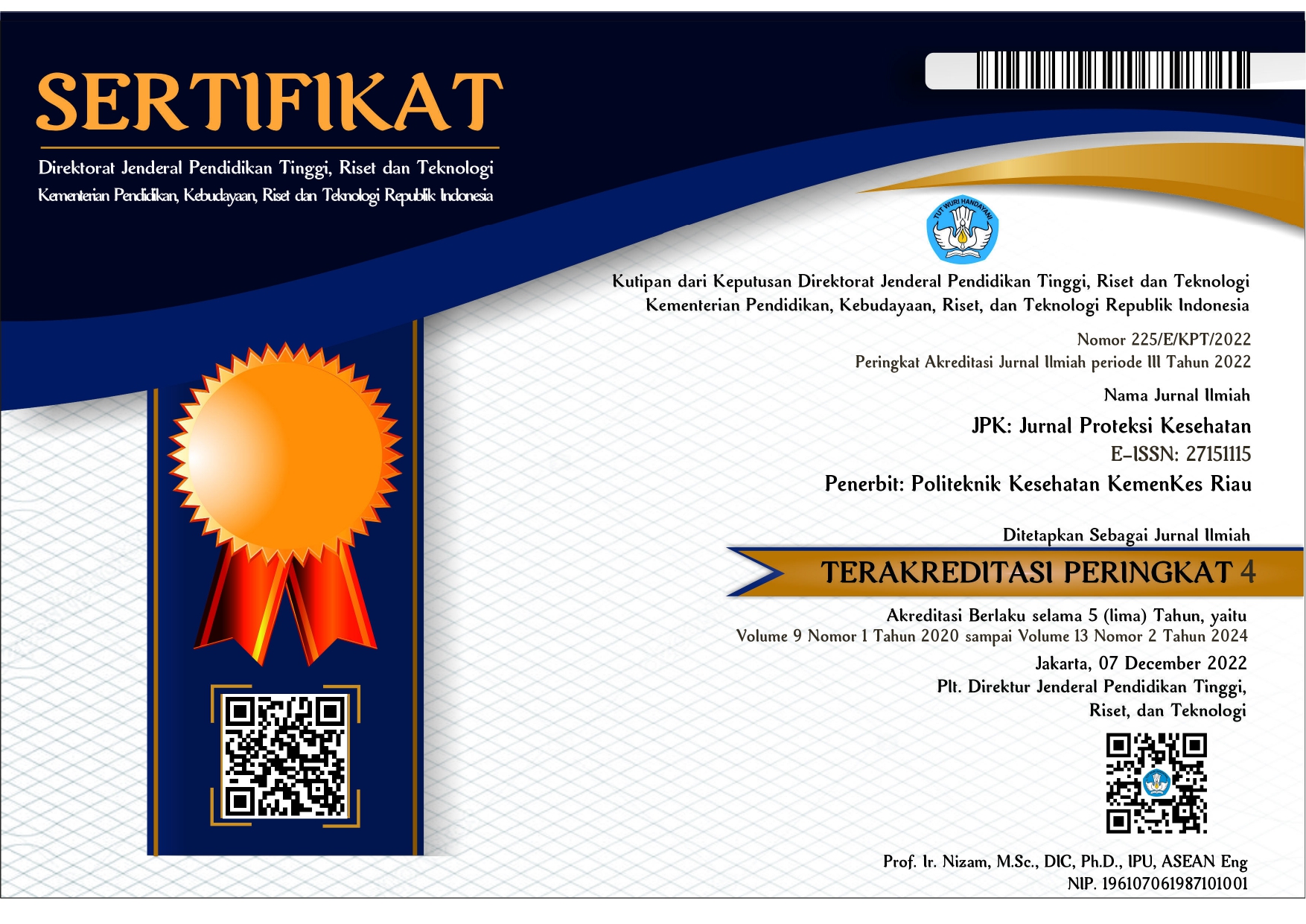Analysis of Differences in Diagnostic Reference Level Based on Size Specific Dose Estimate
Abstract
Diagnostic Reference Level (DRL) is the efforts in implementation of radiation protection of medical exposure to X-ray modalities, Computed Tomography scan (CT scan) and general Radiography. Size Specific Dose Estimates (SSDE) is the dose value of an area received by patient in CT examination. Meanwhile, Dose Length Product correction (DLPc) is the total dose received by patient obtained from multiplying SSDE and scan lenght. The purpose was to analyze difference of DRL based on SSDE between manual measurement and indoseCT v.20.b. This research is descriptive quantitative, by collecting head CT DICOM data. The results showed diagnostic reference level of manual measurement was 59.62 mGy (SSDE) and 1492.86 mGy.cm (DLPc). Meanwhile, the DRL of indoseCT v.20.b measurements were 66.65 mGy (SSDE) and 1551.56 mGy.cm (DLPc). There is no significant difference in the DRL based on SSDE from both methods based on statistical tests. So, the use of indoseCT v.20.b is more recommended because considered faster in determining DRL based on SSDE.
References
[2] A. J. Lubis, “Pemanfaatan CT-Scan (Computer Tomography) Dalam Dunia Medis,” Semin. Nas. Teknol. Inf. Komun., vol. 1, no. 1, pp. 393–398, 2020, [Online]. Available: www.snastikom.com
[3] D. Kartawiguna, instrumentasi Pemindai Tomografi Komputer (CT SCAN). Yogyakarta: Pustaka panasea, 2017.
[4] E. Seeram, Computed Tomography Physical Principles, Clinical Applications, vol. 15, no. 3. 2016.
[5] I. Thierry-Chef et al., “Assessing organ doses from paediatric CT scans-A novel approach for an epidemiology study (the EPI-CT study),” Int. J. Environ. Res. Public Health, vol. 10, no. 2, pp. 717–728, 2013, doi: 10.3390/ijerph10020717.
[6] R. Lestari and N. Heru, “Evaluasi Nilai Noise dan Uniformity Citra CT Scan Sebelum dan Setelah Kalibrasi Harian Makalah Penelitian Menyerahkan Diterima Terbit Computed Tomography ( CT ) Scan merupakan modalitas pencitraan medis yang dapat menampilkan citra tampang lintang tubuh d,” J. Pengawas. Tenaga Nukl., vol. 2, no. 1, pp. 6–12, 2022.
[7] C. Anam et al., “A Simplified Method for the Water Equivalent Diameter Calculation to Estimate PATIENT Dose in CT Examinations,” Radiat. Prot. Dosimetry, vol. 185, no. 1, pp. 42–49, 2019, doi: 10.1093/rpd/ncy214.
[8] K. Baharuddin and E. Juarlin, “Estmasi Dosis Radiasi Pada Pemeriksaan CT Scan Kepala,” http://digilib.unhas.ac.id/, pp. 2–7, 2018.
[9] C. S. Burton and T. P. Szczykutowicz, “Evaluation of AAPM Reports 204 and 220: Estimation of effective diameter, water-equivalent diameter, and ellipticity ratios for chest, abdomen, pelvis, and head CT scans,” J. Appl. Clin. Med. Phys., vol. 19, no. 1, pp. 228–238, 2018, doi: 10.1002/acm2.12223.
[10] M. Irsal, A. N. Mukhtar, G. Winarno, and G. Sari, “The Effect of Kilovoltage and Milliampere-Second Parameters on CT Number: Study Phantom Quality Control CT Scan,” SANITAS J. Teknol. dan Seni Kesehat., vol. 13, no. 2, pp. 237–244, 2022, doi: 10.36525/sanitas.2022.20.
[11] Badan Pengawas Tenaga Nuklir (BAPETEN), “Keputusan Kepala Badan Pengawas Tenaga Nuklir Nomor 1211/K/V/2021 Tentang Penetapan Nilai Tingkat Panduan Diagnostik Indonesia (Indonesian Diagnostic Reference Level) Untuk Modalitas CT-Scan Dan Radiografi Umum,” Badan Pengawas Tenaga Nukl. republik Indones., p. 4, 2021.
[12] J. Tabesh and M. Maziyar, “determination of DRL in Common Computed Tomography examination with The modified quality control Based Dose Survey Method in four University Centers : A comparison of Method,” J. Biomed Phys Eng, vol. 11, no. June, 2021, doi: 10.31661/jbpe.v0i0.2105-1322.Keywords.
[13] R. S. Masuku, “Analisis nilai Computer Tomography Dose Index (CTDI) Dan Dose Length Product (DLP) Pada Pemeriksaan Multislice Computed Tomography (MSCT) Trauma Kepala Dewasa Di Instalasi Radiologi Rumah Sakit Balimed Denpasar Bali,” J. Ilm. Multidisiplin, vol. 1, no. 10, pp. 1235–1243, 2023.
[14] A. Mohammadbeigi, K. Khoshgard, A. Haghparast, and M. T. Eivazi, “Local DRLS for Paediatric CT Examinations Based on Size Specific dose Estimate in Kermanshah, Iran,” Radiat. Prot. Dosimetry, vol. 186, no. 4, pp. 496–506, 2019, doi: 10.1093/rpd/ncz056.
[15] C. Anam, U. Diponegoro, F. Haryanto, I. Arif, G. Dougherty, and C. Islands, “IndoseCT,” no. September, 2017.
[16] E. Vañó et al., Annals o f the ICRP, vol. 44, no. 1. 2015. [Online]. Available: www.icrp.org
[17] Nihayati Rizki, Choirul Anam, Heri Sutanto, and Geoff Dougherty, “Accuracy of IndoseCT for Measuring Effective Diameter from axial CT Images,” Int. J. Sci. Res. Sci. Technol., February, pp. 434–445, 2023, doi: 10.32628/ijsrst2310136.
[18] D. ayu Wardhani, “Penentuan Drl Pada Pemeriksaan Ct-Scan Abdomen Berdasarkan Imt Dan Ssde (Size-Specific Dose Estimate) Di Provinsi DKI Jakarta,” Universitas Nasional, 2022.
[19] Adinda rizki wardana, “Analisis Diagnostic Reference Level (DRL) Pemeriksaan CT-Scan Kepala Berdasarkan Nilai Size-Specific Dose Estimate (SSDE),” Thesis. Universitas Airlangga. 2023.
[20] I. Andriani, W. S. Budi, H. Sutanto, and C. Anam, “I nternational J ournal of A llied M edical S ciences and C linical R esearch ( IJAMSCR ) Analysis of the Effect of Phantom CT Scan Diameter Variations on Radiation Dose with IndoseCT,” vol. 7, no. 1, pp. 21–27, 2019.












